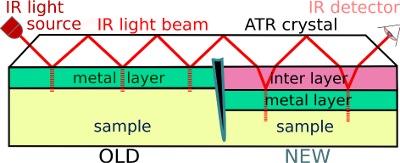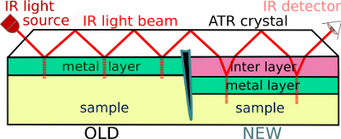Optical design of interfaces
Metal/electrolyte interfaces for spectroscopic applications

The main challenge for analysing metal/electrolyte interfaces with in situ optical spectroscopy is the delivery of light to the examined interface. Because both the electrolyte and metal attenuate the intensity of light through absorption, methods for increasing the intensity at the surface under study need to be developed. In the infrared spectral range, the absorption is particularly strong. We are using two different approaches to solve this issue for infrared light. Both employ a high-refractive index semiconductor as medium of incidence, on which metal is deposited and brought into contact with a solution. The first approach increases transmission through continuous metal films. The second approach uses small metal particles at the surface and therefore offers a path towards designing a well-defined, non-planar model interface.
More recently, we started to study whispering gallery modes in microresonators with the aim of using them in highly sensitive spectroscopy at interfaces.
Publications:
•Rakesh Singh Moirangthem, Andreas Erbe: Interfacial refractive index sensing using visible-excited intrinsic zinc oxide photoluminescence coupled to whispering gallery modes. Applied Physics Letters, 103, 051108 (2013).
•Ganesh Vasan, Andreas Erbe: Incidence angle dependence of enhancement factor in attenuated total reflection surface enhanced infrared absorption spectroscopy studied by numerical solution of the vectorial Maxwell equations. Physical Chemistry Chemical Physics, 14, 14702-14709 (2012).
•Ganesh Vasan, Ying Chen, Andreas Erbe: Computation of surface-enhanced infrared absorption spectra of particles at a surface through the Finite Element Method. Journal of Physical Chemistry C, 115, 3025-3033 (2011).
•Martina Reithmeier, Andreas Erbe: Application of thin film interference coatings in infrared reflection spectroscopy of organic samples in contact with thin metal films. Applied Optics, 50, C301-C308 (2011).
•Martina Reithmeier, Andreas Erbe: Dielectric interlayers increasing the transparency of metal films for mid-infrared attenuated total reflection spectroscopy. Physical Chemistry Chemical Physics, 12, 14798-14803 (2010).
Web-Resources:
reflcalc, our tool to simulate reflection spectra of multilayer systems
Rough surfaces
Real materials surfaces are rough, and light absorption and reflection are affected by the roughness. Full analysis of the effect of roughness is still challenging.
Publications:
•Michael Auinger, Petra Ebbinghaus, Adrian Blümich, Andreas Erbe: Effect of Surface Roughness on Optical Heating of Metals. Journal of the European Optical Society Rapid Publications, 9, 14004 (2014). Direct link to the PDF.
